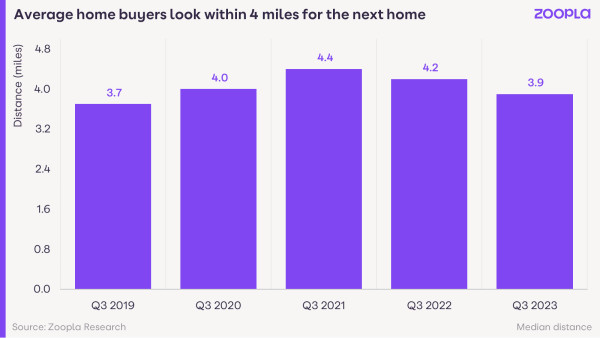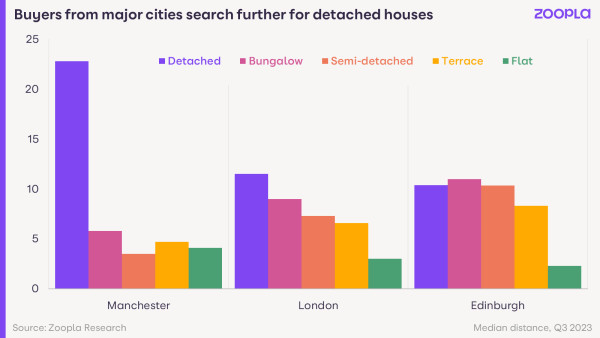The average buyer looks for their next home 3.9 miles down the road, but people in the south and in cities are much more likely to spread their wings.
As a nation we don’t look far for our next home. We tend to think local first, and search in areas that we know and love.
But looking in a wider search area may give you more affordable options or help you buy a bigger property.
Let’s explore the trends in how far people are looking to move and how this varies across the country.
People search for a home 3.9 miles away on average
Our data shows that the average buyer is looking for their next home 3.9 miles down the road, while 3 in 4 people only enquire on homes in one or two neighbourhoods.
In 2021, the distance between someone’s home and a home they enquired about was slightly higher at 4.4 miles.
During the pandemic, many households were open to a change in lifestyle and, as markets became more competitive, buying further away was a useful tactic. It helped people find a home that fitted within their budget as house prices soared.
Back in summer 2019, buyers only searched 3.7 miles away on average. The difference now is that there are more properties for sale across the UK, which is creating greater choice locally and supports people to search closer to home.

Southerners look further away while buyers in the North stay local
Our data shows large regional differences in where people are looking for their next property.
Half of buyers in the East of England and 43% of buyers in the South East are looking for a home 10 miles away or further. They’re more open to the idea of moving to a town down the road or to the other side of a city.
On the other hand, buyers in the North of England and Midlands are generally enquiring for local properties. 60% of buyers in these regions look for their next home within a 5-mile radius – higher than the national average of 50%.
Importantly, these trends mirror the pre-pandemic moving patterns. They tell us that distance is inherent in moving decisions for many buyers in the south. People may choose to buy further away because of different local economies, the availability of different property types and how expensive properties are in a given area.
In the peak of the Covid-19 home-moving boom, headlines cited a mass exodus from the capital. Our data shows that the proportion of London-based buyers enquiring about properties located 20 miles or further away from their home increased from 18% in summer 2019 to 24% in summer 2021. This is a meaningful change, but not enough to call it a mass exodus.
Londoners are looking closer to home now, but a third of buyer demand from Londoners is for homes at least 10 miles away. Housing unaffordability and lack of houses in inner London create pressure on buyers to move further away.
| Buyer’s home region | Median distance to enquiry property (miles) | Proportion of buyers looking for their next home beyond 10 miles |
|---|---|---|
| East of England | 8.9 | 50% |
| South East | 5.7 | 43% |
| Scotland | 4.7 | 35% |
| London | 4.6 | 34% |
| South West | 3.4 | 31% |
| Wales | 3.3 | 25% |
| North West | 3.0 | 25% |
| North East | 2.9 | 22% |
| West Midlands | 2.9 | 21% |
| East Midlands | 2.8 | 26% |
| Yorkshire and the Humber | 2.6 | 20% |
| UK | 3.9 | 32% |
September 2023
City dwellers search further so they can buy houses over flats
People looking for less common property types, such as bungalows or detached houses, are more likely to look further afield. Certain property types are simply not available to buy in some areas.

For instance, people in Manchester, where only 1 in 27 properties on the market is a detached house, look 23 miles away on average to buy such a home.
Similarly, London-based buyers looking for detached houses enquire for properties typically located 11.5 miles away from their current home.
In Edinburgh, where 64% of homes on the market are flats, those aspiring to buy a house typically look for them 10 miles away from their current location.
What are the benefits of moving further away?
For many, choosing where to move next is a balancing act of selecting areas that have the right type of homes at the right price point and fit well with your lifestyle.
People with jobs in the market services sector, which are concentrated in major UK cities but allow for remote working, have more flexibility to move further afield. For others, moving choices will be more driven by employment opportunities.
It also comes down to what type of home you want to live in. People in cities struggle to find larger houses, while those based in more rural locations have limited options when it comes to flats. As a buyer, you may have to explore more than one or two areas to find your dream property type.
If you’re based in a region where it’s more expensive to buy, looking further afield into more affordable areas could mean better value for money and smaller mortgage repayments.
Key takeaways
- Most people search for their next home locally, with the average buyer looking just 3.9 miles away
- Those in the South East and East of England are more likely to move beyond 10 miles to find more space and value
- People in the North of England and the Midlands are more likely to stay local – 60% of buyers in these regions search for their next home within a 5-mile radius
- City dwellers look as far as 23 miles away to find larger properties
- Looking further away for a home can open up your options to different types of properties and more affordable house prices
